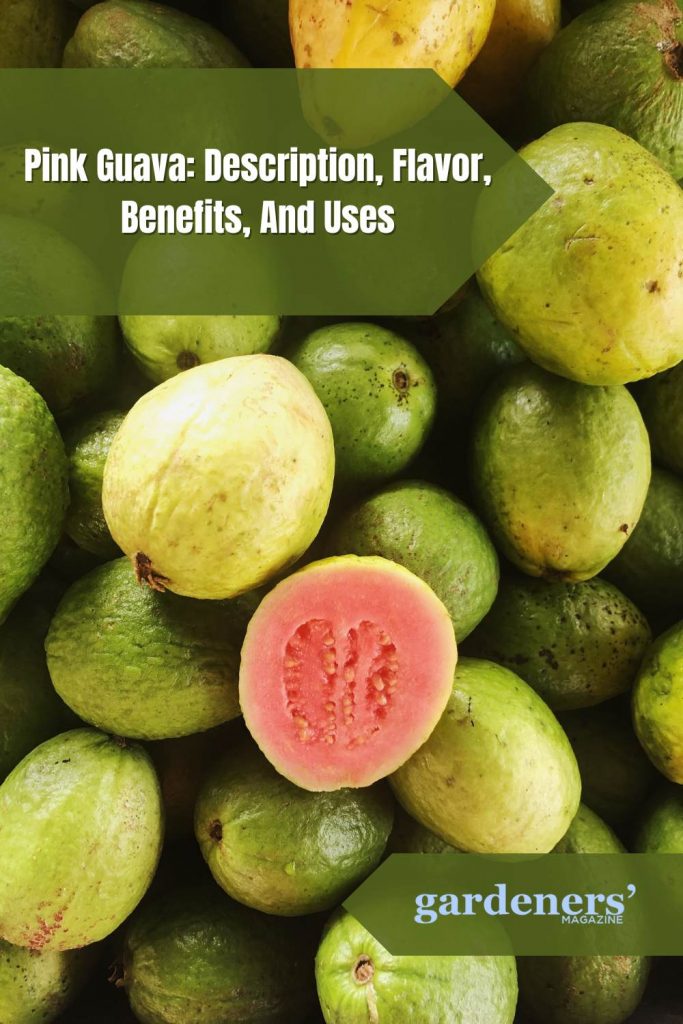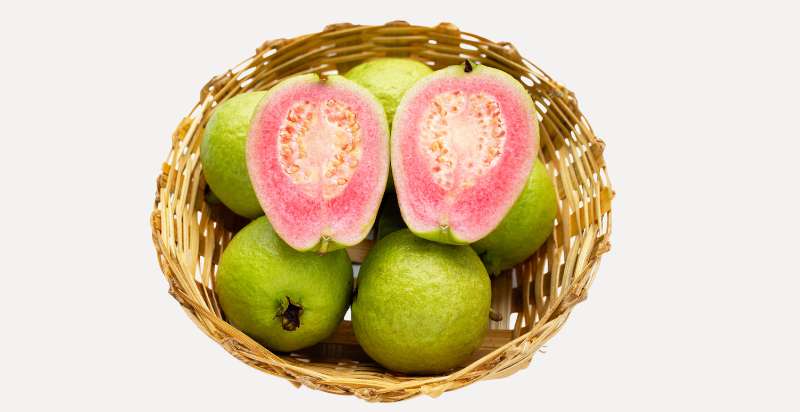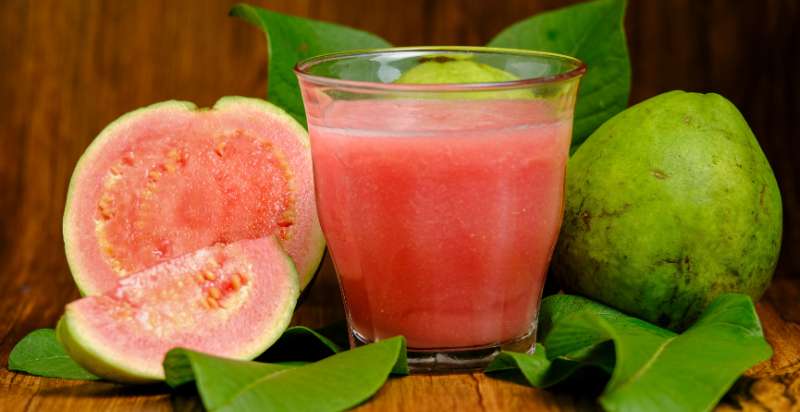Pink guava is a tropical fruit native to Mexico and Central and South America. It has a sweet, juicy, fragrant flavor similar to the white variety but with bright pinkish-red flesh. Pink guavas are packed full of vitamins, minerals, and antioxidants that can help keep your body healthy. They’re also low in calories and fat, making them a great snack for those trying to lose weight or maintain a healthy diet. Plus, they have the bonus of being delicious! Here’s what you need to know about pink guava.
What is Pink Guava?
Pink guava is a small to medium-sized fruit with bright pinkish-red flesh and a sweet, juicy flavor. It is one of the many varieties of guavas found in tropical climates worldwide. The skin of the guava can vary in color from yellow to green or even deep purple, depending on where it was grown – but all have a yellowish-white interior. The edible seeds are also present inside the guava.

History and Origin of Pink Guava:
Pink guava, known as Psidium guajava, has existed since ancient times. The fruit is native to Central America and the Caribbean and cultivated by the early Mayan and Aztec civilizations. Pink guavas were also a popular food source for many cultures living in tropical regions worldwide before their introduction into Europe and North America. Today, this juicy fruit can be found growing in warm climates across the globe, providing an excellent source of dietary fiber, Vitamin C, and other essential nutrients for those who enjoy its sweet flavor. Its unique coloration – varying shades of pink-reds – make it highly sought after in markets everywhere.
As with any fruit, though, there are some potential risks to consider before consuming pink guavas, such as the presence of certain toxins and other microorganisms. Thus, it is important to consult a healthcare provider before adding this delectable treat to your diet. Nonetheless, its popularity continues to increase partly due to its delicious flavor and undeniable health benefits. So enjoy some pink guava for yourself – just be sure to do so safely and responsibly.
Description of the Pink Guava:
Pink guavas are tropical fruit about 3 to 5 cm in diameter. The fruits have a thin pinkish-red skin with white flesh underneath. They are sweet and juicy, with a unique floral aroma and flavor, making them an excellent addition to salads, desserts, and smoothies. The small seeds can easily be removed for added convenience.
Flavor Profile of the Pink Guava:
The Pink Guava is known for its sweet and mild flavor. It has a melon-like taste with a hint of raspberry, making it a great choice for juicy and flavorful fruit. The texture of the flesh is soft and creamy, while the outer skin is slightly firm. Its aroma can be described as tropical, with notes of pear, mango, and pineapple.
Health Benefits of Pink Guava:
Pink guava is an excellent addition to many recipes. It has a sweet and slightly acidic flavor that can brighten any dish. The fruit also offers many health benefits, making it an ideal ingredient for healthy meals. One of the primary benefits of adding pink guava to your diet is its high concentration of Vitamin C. This antioxidant helps fight off free radicals and boost immunity. Pink guava also has a high amount of dietary fiber, which helps digestion and aids in maintaining a healthy weight. The fruit helps you stay fuller for longer, helping you avoid unhealthy snacking between meals.
Pink guava is also rich in many minerals, such as potassium, calcium, magnesium, and iron. These minerals help maintain bone health, control blood pressure, and promote cardiovascular health. The fruit can also help reduce inflammation due to its high content of carotenoids and polyphenols.
Cultivation of the Pink Guava:
The Pink Guava is a subtropical fruit tree native to South and Central America. It grows best in full sun, with well-draining soil of average fertility. The tree should be planted at least 2 feet away from other plants or trees for optimal growth and fruiting. The roots of the guava should be kept moist but not overly saturated; when irrigating, provide the soil with 1 inch of water per week.
Prune the tree as needed to maintain its size and shape and to encourage new fruiting branches. Fertilize in spring and mid-summer with a balanced fertilizer at a rate of 2 pounds per 100 square feet. The Pink Guava is a self-fertile variety, so no additional male trees are required for pollination. The fruit can be harvested from late summer to early winter, depending on the variety.
Harvesting of the Pink Guava:
Harvesting of the Pink guava can be done when they reach a size of about 4-5 cm in diameter. The fruits should be handpicked and carefully handled as their skin is delicate. Fruits may be picked from trees when they turn from green to light yellow but are still firm to the touch. Harvesting can also occur when the fruit turns pinkish-orange or even purple. Picking at this stage allows for harvesting the sweetest and most flavorful fruits. Harvesting should occur daily as the guava will not ripen further after being picked, meaning there is no benefit in leaving them on the tree for too long.
It is important to note that while harvesting of the Pink guava may begin in late spring or early summer, their peak season is during fall and winter. This is when they are at their sweetest and most flavorful. Once harvested, the fruits should be stored in a cool and dark place to remain fresh. It is also important to keep the fruits away from direct sunlight as this can cause them to spoil faster.

Where does Pink Guava Grow?
Pink guava is grown in many parts of the world. In India, it is mainly cultivated in Maharashtra, Gujarat, Madhya Pradesh, and Karnataka. In Asia, pink guava can be found in the Philippines, Thailand, Vietnam, and Myanmar.
In South America, this fruit is grown mostly in Peru and Brazil. In Africa, it can be found in countries like Egypt, Ethiopia, and Tanzania. Pink guava is also grown in the Caribbean Islands, such as Jamaica, Puerto Rico, and St. Lucia. In Europe and North America, pink guavas are mainly grown in California and Florida but can also be found in other parts of the US, Canada, Greece, and Mexico. The pink guava is a popular fruit worldwide, becoming more readily available in stores. So, no matter where you live, if you’re looking for delicious and nutritious fruit, the pink guava is worth the try.
What do you need to keep in mind when buying Pink Guava?
When purchasing pink guava, there are a few things to remember. Firstly, you should always look for fruit that is firm to the touch and free from blemishes or brown spots. The fruit’s skin should be slightly fragrant, as this indicates freshness. Secondly, it is important to select guavas that are heavy for their size. Lastly, check the color of the flesh—it should be pale pink to reddish in hue.
The flavor and sweetness of guavas can vary depending on how ripe they are, so it is best to choose fruit that is not overly soft or hard but gives slightly when pressed gently with your thumb. Guavas should be consumed quickly after purchase, as they can spoil quickly. It’s best to store them in the refrigerator for up to a week or at room temperature for a few days.
What is the Best Way to Store Pink Guava?
The best way to store pink guava is to keep it in the refrigerator. Ensure you store them in a container that will maintain moisture and air circulation. This will help prevent the fruit from getting too dry or moldy. You can also wrap each guava with plastic wrap to preserve its freshness.
If you are going to wait to eat the guava, it is best to store them in the coldest part of your refrigerator. Storing them at room temperature can lead to over-ripening or spoiling. Additionally, ensure not to wash the guavas until you are ready to eat them, as washing them beforehand may cause them to spoil faster. Finally, check the fruits regularly for any signs of spoilage or mold.
How to use Pink Guava in recipes with others?
Pink guava can be used in a variety of recipes, both sweet and savory. Mix it with mango puree and cream cheese for an elegant dessert or a delicious cheesecake. Or combine guava puree with whipped cream to make a smooth filling for tarts or pies. For savory dishes, mix the pink guava with coconut milk and some spices for a flavorful curry. You can add it to your favorite salsa recipe for a sweet twist. Or combine it with garlic, onion, ginger, and lime juice to make an Asian-inspired marinade for chicken or pork. Make a savory stir fry with Thai guava slices, bell peppers, onions, and your favorite vegetables. Add a few spoonfuls of honey to the sauce for a sweet and spicy flavor
Pink guavas can also be cooked into a jam or jelly, perfect on toast, or added to cakes and pastries. You can add it to smoothies or protein shakes for natural sweetness. No matter how you use pink guava, you will surely have a flavorful dish that your friends and family will love.

Conclusion:
Pink guava is a delicious and versatile fruit that can be used in various recipes. When selecting the perfect pink guava, look for ones with good color, mature texture, and no signs of spoilage or mold. Store them in the coldest part of your refrigerator until you can use them. Add pink guava to your favorite desserts or savory dishes for a sweet twist! With its unique flavor profile and beautiful hue, pink guava will surely take your dishes up a notch!
- Everything You Wanted to Know About Red Tamarillos - June 2, 2025
- A Guide to Tulips: Everything You Need to Know & More… - June 2, 2025
- Guanabana: Description, Flavor, Benefits, And Uses - May 27, 2025

2 thoughts on “Pink Guava: Description, Flavor, Benefits, And Uses”
Comments are closed.